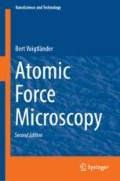Abstract
We consider basic requirements for force sensors and introduce a fabrication process for cantilevers. Subsequently, the most common detection method for measuring the cantilever deflection, the beam deflection method, is discussed in detail.
Access this chapter
Tax calculation will be finalised at checkout
Purchases are for personal use only
Notes
- 1.
The bending of the cantilever end by the angle \(\theta \) results in an angle of \(2 \theta \) for the reflected beam. Thus, the linear deflection of the reflected laser beam on the photodiode results (for small angles) as \(\Delta x = 2 \theta L\).
- 2.
In dynamic AFM the primary bandwidth detecting the oscillatory motion of the cantilever is much larger than 1 kHz used in this quantitative example, however, in this case also the oscillation amplitudes to be detected exceed the pm range by far.
- 3.
If the cantilever is tilted with respect to the surface by an angle \(\alpha \), the relation between the force perpendicular to the surface and the deflection perpendicular to the surface is modified [9] to \(F = k \Delta z/ \cos ^2 \alpha \). Since \(\alpha \) is usually small (in the range between \(10^{\circ }\) and \(15^{\circ }\)), this correction is small and will be neglected it in the following.
- 4.
Specific effects occurring close to the kink between the two regions are discussed in Sect. 12.5.
- 5.
The parameters \(\omega _0\) and Q can be obtained by measuring a resonance curve of the cantilever in response to an external excitation (frequency sweep over the resonance). Alternatively, the thermal noise spectrum can be measured, as described in the next section.
- 6.
The density and viscosity for the most frequently used fluids (air and water) are: \(\rho _{\mathrm {air}} = 1.2\,\)kg/m\(^3\), \(\eta _{\mathrm {air}} = 1.85\times 10^{-5}\) kg/(m s), and \(\rho _{\mathrm {water}} = 1\times 10^3\) kg/m\(^3\), \(\eta _{\mathrm {water}} = 8.9\times 10^{-4}\) kg/(m s), respectively, under ambient conditions and at sea level [12].
- 7.
Details of how to extract the noise power spectral density from the time signal without using a spectrum analyzer are given in Appendix B or [15].
References
C.H. Oon, J.T.L. Thong, Y. Lei, W.K. Chim, High-resolution atomic force microscope nanotip grown by self-field emission. Appl. Phys. Lett. 81, 3037 (2002). https://doi.org/10.1063/1.1515120
W.D. Pilkey, Formulas for Stress, Strain and Structural Matrices, 2nd edn. (Wiley, New York, 2005). https://doi.org/10.1002/9780470172681
F. Reif, Fundamentals of Statistical and Thermal Physics, (Waveland Pr. Inc., 1965) ISBN 1577666127
G. Meyer, N.M. Amer, Novel optical approach to atomic force microscopy. Appl. Phys. Lett. 53, 1045 (1989). https://doi.org/10.1063/1.100061
Y. Martin, C.C. Williams, H.K. Wickramasinghe, Atomic force microscope force mapping and profiling on a sub 100 Å scale. J. Appl. Phys. 61, 4723 (1987). https://doi.org/10.1063/1.338807
D. Rugar, H.J. Mamin, P. Guethner, Improved fiberoptic interferometer for atomic force microscopy. Appl. Phys. Lett. 55, 2588 (1989). https://doi.org/10.1063/1.101987
M. Tortonese, R.C. Barrett, C.F. Quate, Atomic resolution with an atomic force microscope using piezoresistive detection. Appl. Phys. Lett. 62, 834 (1993). https://doi.org/10.1063/1.108593
D. Kiracofe, K. Kobayashi, A. Labuda, A. Raman, H. Yamada, High efficiency laser photothermal excitation of microcantilever vibrations in air and liquids. Rev. Sci. Instrum. 82, 013702 (2011). https://doi.org/10.1063/1.3518965
J.L. Hutter, Comment on tilt of atomic force microscope cantilevers: effect on spring constant and adhesion measurements. Langmuir 21, 2630 (2005). https://doi.org/10.1021/la047670t
J.E. Sader, J.W.M. Chon, P. Mulvaney, Calibration of rectangular atomic force microscope cantilevers. Rev. Sci. Instrum. 70, 3967 (1999). https://doi.org/10.1063/1.1150021
J.E. Sader, J.A. Sanelli, B.D. Adamson, J.P. Monty, X. Wei, S.A. Crawford, J.R. Friend, I. Marusic, P. Mulvaney, E.J. Bieske, Spring constant calibration of atomic force microscope cantilevers of arbitrary shape. Rev. Sci. Instrum. 83, 103705 (2012). https://doi.org/10.1063/1.4757398
S.M. Cook, T.E. Schäffer, K.M. Chynoweth, M. Wigton, R.W. Simmonds, K.M. Lang, Practical implementation of dynamic methods for measuring atomic force microscope cantilever spring constants. Nanotechnology 17, 2135 (2006). https://doi.org/10.1088/0957-4484/17/9/010
M. Godin, V. Tabard-Cossa, P. Grütter, Quantitative surface stress measurements using a microcantilever. Appl. Phys. Lett. 79, 551 (2001). https://doi.org/10.1063/1.1387262
J.L. Hutter, H. Bechhoefer, Calibration of atomicforce microscope tips. Rev. Sci. Instrum. 64, 1868 (1993). https://doi.org/10.1063/1.1143970
G. Heinzel, A. Rüdiger, R. Schilling, Spectrum and spectral density estimation by the Discrete Fourier Transform (DFT), including a comprehensive list of window functions and some new at-top windows (2002). http://pubman.mpdl.mpg.de/pubman/item/escidoc:152164:1/component/escidoc:152163/395068.pdf
M.J. Higgins, R. Proksch, J.E. Sader, M. Polcik, S. Mc Endoo, J.P. Cleveland, S.P. Jarvis, Noninvasive determination of optical lever sensitivity in atomic force microscopy. Rev. Sci. Instrum. 77, 013701 (2006). https://doi.org/10.1063/1.2162455
Author information
Authors and Affiliations
Corresponding author
Rights and permissions
Copyright information
© 2019 Springer Nature Switzerland AG
About this chapter
Cite this chapter
Voigtländer, B. (2019). Cantilevers and Detection Methods in Atomic Force Microscopy. In: Atomic Force Microscopy. NanoScience and Technology. Springer, Cham. https://doi.org/10.1007/978-3-030-13654-3_11
Download citation
DOI: https://doi.org/10.1007/978-3-030-13654-3_11
Published:
Publisher Name: Springer, Cham
Print ISBN: 978-3-030-13653-6
Online ISBN: 978-3-030-13654-3
eBook Packages: Chemistry and Materials ScienceChemistry and Material Science (R0)

